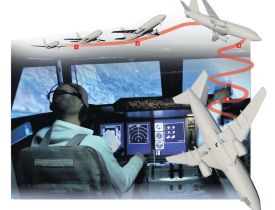 Pilots must also be able to train for exceptional situations in a simulator. In the SUPRA project, researchers worked to develop technological breakthroughs aimed at making flight simulators suitable for such situations.
Pilots must also be able to train for exceptional situations in a simulator. In the SUPRA project, researchers worked to develop technological breakthroughs aimed at making flight simulators suitable for such situations.
Upset
In this European project, which NLR and partners recently completed, new technologies for flight simulators were developed. This allows commercial pilots to be trained to learn how to control upset conditions, which is something that is too risky and expensive to do during a real flight. An uncontrollable aircraft during upset conditions ‘loss-of-control’ is the leading cause of aircraft accidents worldwide.
An ‘upset’ is defined as any (unexpected) deviation from the normal flight path, such as extreme nose or wing positions (unusual attitude ) or too low flight speeds, which runs the risk of a stall occurring, whereby the lift fails. Extreme weather conditions, short-circuits or damage to the aircraft can also lead to an upset occurring.
Skid courses
In the simulators, pilots are trained to quickly and proficiently regain control during abnormal situations. The current generation of flight simulators offer improved simulations of normally flying aircraft, but they are not yet sufficiently proficient at simulating an aircraft that is in an upset situation. The SUPRA project aims to improve flight simulators for this purpose and to satisfactorily simulate and train pilots for the exceptional flight characteristics that occur during an upset. In fact, SUPRA improved the skid courses offered to pilots, thus making a major contribution to safety.
Lift
One of these unintentional movements occurs during a ‘stall’, when the aircraft’s speed decreases, causing a momentary shortage of lift over the wings and the aircraft to rapidly lose altitude. Complex aerodynamic effects occur during this manoeuvre, causing the aircraft to move in ways that cannot be well-trained in the current generation of simulators. Gaining a thorough understanding of these aerodynamic effects has led to a more realistic simulation of a flight during these conditions.
Test pilots
Certain manoeuvres are then ‘translated’ into movements for the simulator, which the pilots experience realistically. For this, GRACE, the NLR’s flight simulator, is used. This offers a safer method for allowing pilots to see and feel the conditions that occur when they lose control of an aircraft and also what they must do in order to regain control of the upset situation. Test pilots from Boeing, Airbus and NLR tested the model in GRACE. Moreover, pilots from various airline companies were invited to experience the improvements made to the simulator for upset trainings.
The project concluded with an international symposium held in Soesterberg, which was attended by representatives from leading aviation organisations. During the symposium, the improvements made to the simulator were demonstrated for the various stakeholders. The great interest in the SUPRA project’s findings reveal that upset trainings are now being given greater priority, in order to address the loss of control problem on a global scale. The facilities developed by NLR and partners within SUPRA offer support for the implementation of improved upset trainings for certified organisations and industry.
Video
Watch here the SUPRA video clip.


